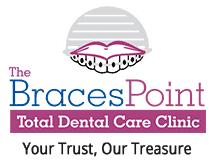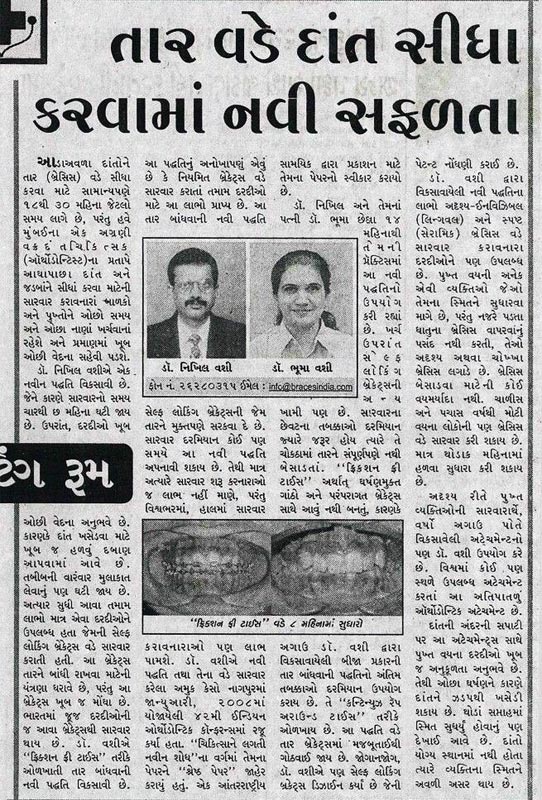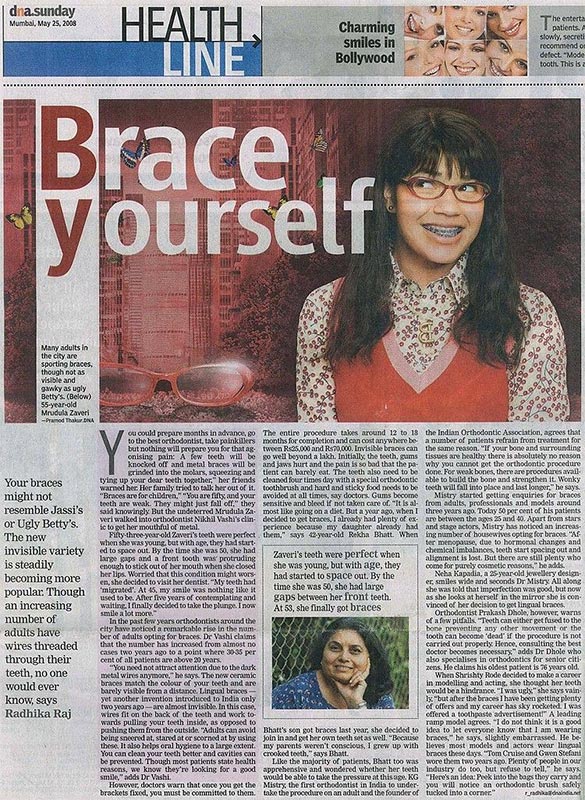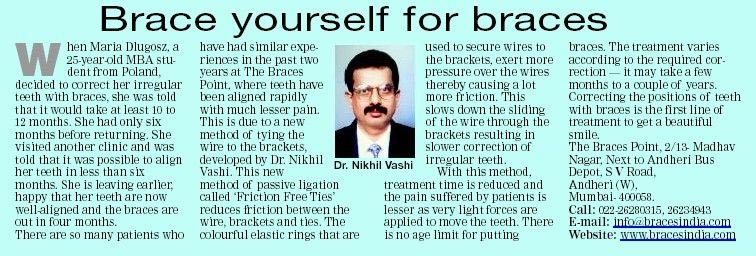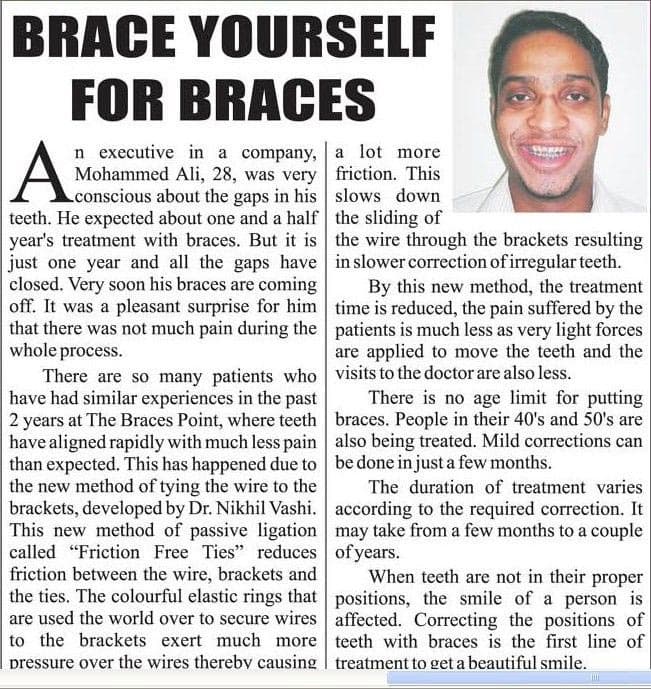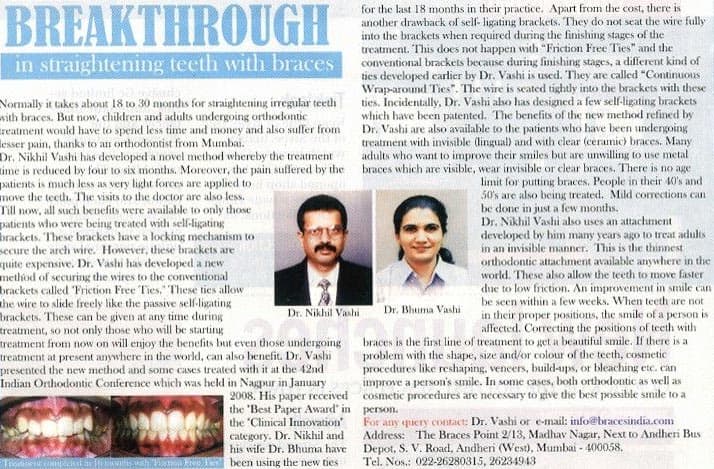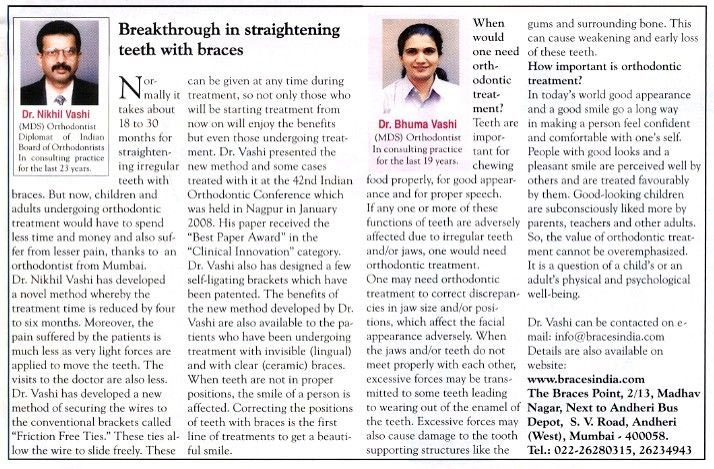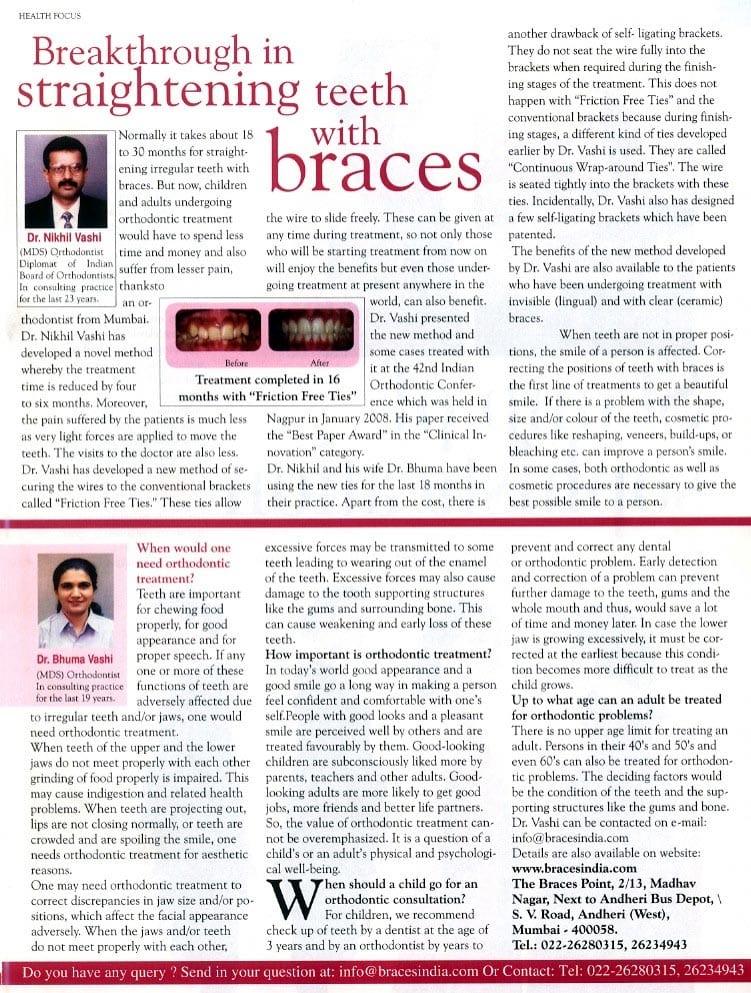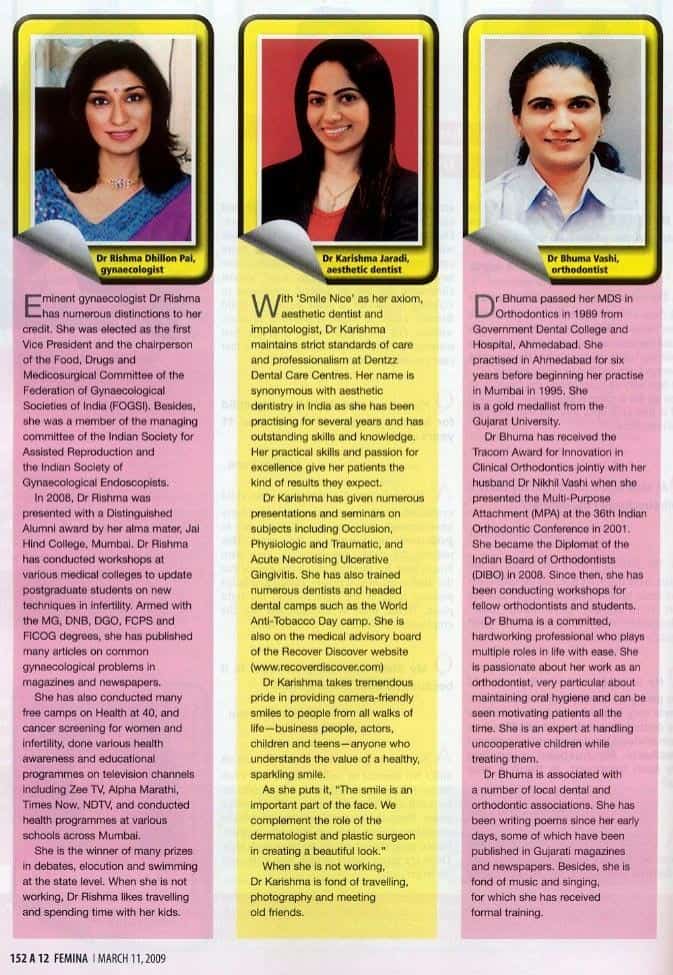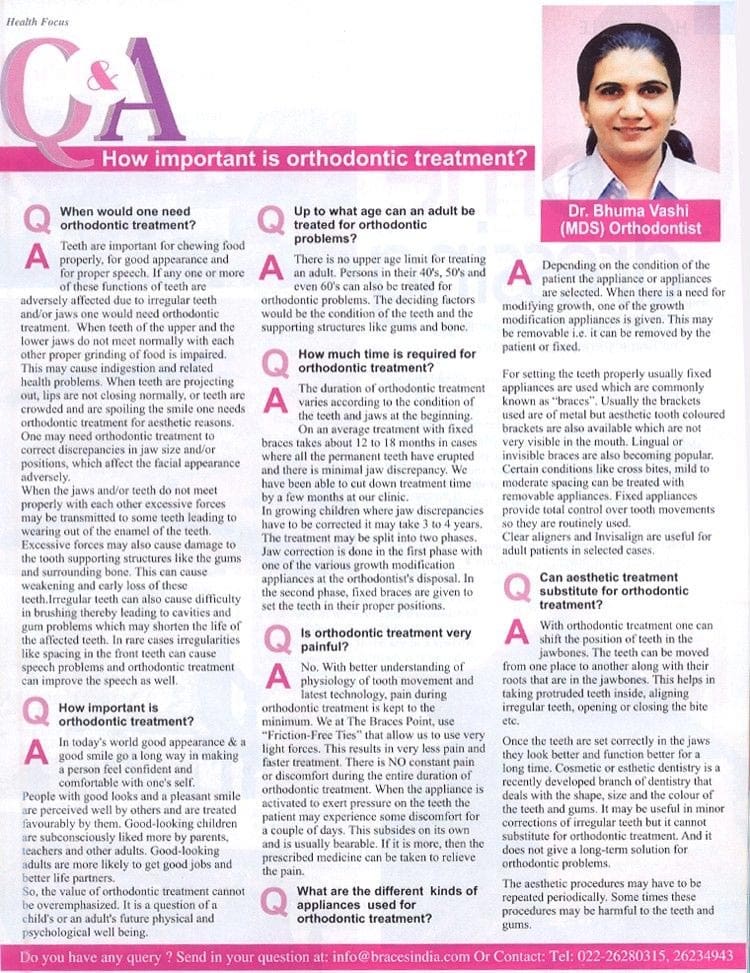Call for Appointment
+91 91379 30546Email for Appointment
appointment@thebracespoint.comClinic Address
2/13, Madhav Nagar, Next to Andheri Bus Depot, Andheri WestBraces
Teeth are important for chewing food properly, for good appearance and for proper speech. If any one or more of these functions of teeth are adversely affected due to irregular teeth and/or jaws, one would need orthodontic treatment.
When teeth of the upper and the lower jaws do not meet properly with each other grinding of food properly is impaired. This may cause indigestion and related health problems.
When teeth are projecting out, lips are not closing normally, or teeth are crowded and are spoiling the smile, one needs orthodontic treatment for aesthetic reasons.
One may need orthodontic treatment to correct discrepancies in jaw size and/or positions, which affect the facial appearance adversely. When the jaws and/or teeth do not meet properly with each other, excessive forces may be transmitted to some teeth leading to wearing out of the enamel of the teeth. Excessive forces may also cause damage to the tooth supporting structures like the gums and surrounding bone. This can cause weakening and early loss of these teeth.
Irregular teeth can also cause difficulty in brushing thereby leading to cavities and gum problems which may shorten the life of the affected teeth.
In rare cases irregularities like spacing in the front teeth can cause speech problems and orthodontic treatment can improve the speech as well.
In today's world good appearance and a good smile go a long way in making a person feel confident and comfortable with one's self.
People with good looks and a pleasant smile are perceived well by others and are treated favourably by them.
Good-looking children are subconsciously liked more by parents, teachers and other adults.
Good-looking adults are more likely to get good jobs, more friends and better life partners.
So, the value of orthodontic treatment cannot be overemphasized. It is a question of a child's or an adult's future physical and psychological well-being.
It is recommended that the first check up by an orthodontist should be done by 6 years of age. If a dental or jaw problem is developing it can be corrected as the child grows. If the teeth and the jaws are developing normally then a regular check up should be done every six months to monitor the development.
In case the lower jaw is growing excessively, it must be corrected at the earliest because this condition becomes more difficult to treat as the child grows. Some conditions can be treated later. Certain teeth irregularities can be corrected earlier thereby preventing them from becoming more severe and would need less time to treat later.
There is no upper age limit for treating an adult. Persons in their 40's and 50's and even 60's can also be treated for orthodontic problems. The deciding factors would be the condition of the teeth and the supporting structures like gums and bone.
The duration of orthodontic treatment varies according to the condition of the teeth and jaws at the beginning. On an average, treatment with the fixed braces takes about 1 to 2 years in cases where all the permanent teeth have erupted and there is minimal jaw discrepancy. The treatment time has reduced now with the use of "Friction-Free Ties" developed by us. We are able to complete treatment in a few months in some cases.
In growing children where jaw discrepancies have to be corrected it may take 3 to 4 years. The treatment may be split into two phases. Jaw correction is done in the first phase with one of the various growth modification appliances at the orthodontist's disposal. In the second phase, fixed braces are given to set the teeth in their proper positions.
It is a relative term. Orthodontic treatment costs so much because the treatment goes on for a long duration. There are certain expenses incurred to maintain a high level of sterilization of equipment and asepsis of the clinic. The appliances used are expensive. Thus some amount is spent for the patient himself/herself.
The fees are professional charges for the knowledge, experience and skill of the orthodontist. Considering the long term, positive, physical and psychological benefits of orthodontic treatment whatever spent on orthodontic treatment should be considered as a sound investment.
In the first consultation the patient is examined and the condition of the teeth, jaws, face and the function is assessed. History is taken to know the patient's health condition. Then the patient and the parents are explained about the treatment procedures with the help of computer animations, photographs of treated cases, models etc. The patient is then sent for special x-rays needed for diagnosis and treatment planning.
In the next appointment impressions are taken and the x-rays are collected to study them.
The final treatment plan, expected duration of treatment, and fees etc. are discussed in the next appointment. Once the patient or parents decide for the treatment, appointments are fixed for starting the treatment.
One or more permanent teeth may have to be extracted in some cases to create spaces in the upper and/or the lower arches. Extractions of permanent teeth are not necessary in all the cases.
When the jaw and teeth sizes are normal the teeth can be set in their proper positions without extractions.
When the jaws are small and the teeth are large the teeth get crowded or proclined or both. In such cases extracting teeth creates the necessary spaces to move the remaining teeth in the extraction spaces. This helps in aligning and retracting teeth to more aesthetic positions.
When the jaws are large and teeth small, the teeth get spaced out. These teeth can be aligned and spaces can be closed by orthodontic treatment without any extractions.
The decision to extract or not to extract teeth and which teeth to extract depends on a number of factors like the severity of the malocclusion, amount of space required, the area of crowding, presence of any decayed tooth/teeth or missing tooth/teeth, presence or absence of milk teeth, jaw discrepancies, presence of impacted teeth, presence of extra (supernumerary) teeth, amount of changes required in the facial appearance etc.
The orthodontist studies all the factors and charts out alternate treatment plans and decides on the most favourable treatment plan and then decides about extractions. Usually the first premolars are extracted but depending on the case requirements second premolars, second molars, upper or lower incisors and sometimes even canines may be extracted. The idea is to get the best possible result aesthetically and functionally with a long-term stability of the result.
Extraction of teeth is not painful as the teeth are removed under local anesthesia. The healing also is very quick because there is no infection in the teeth and the jaws.
There is no evidence in scientific literature that extracting teeth weakens or damages eyes or any other parts of the body.
In almost 6/7 out of 10 orthodontic cases teeth have to be extracted. If there actually was any damage to any part of the body it would be known and nobody would take orthodontic treatment.
No. With better understanding of physiology of tooth movement and latest Technology, pain during orthodontic treatment is kept to the minimum.
Initially when an appliance is given there is pressure on the teeth that can cause some discomfort and pain. This can be minimized by timely medication as prescribed by the orthodontist. There is NO constant pain or discomfort during the entire duration of orthodontic treatment. When the appliance is activated to exert pressure on the teeth the patient may experience pain for a couple of days. This subsides on its own and is usually bearable. If it is more, then the prescribed medicine can be taken to relieve the pain.
Depending on the condition of the patient the appliance or appliances are selected. When there is a need for modifying growth one of the growth modification appliances is given. This may be removable i.e. it can be removed by the patient or fixed.
When the lower jaw is deficient or placed behind in relation to the upper jaw either a bionator, activator, twin block may be given.
When the lower jaw is more prominent or growing excessively a chin cap may be used.
Foe a deficient upper jaw a reverse pull head gear may be used. In case of an excessively growing upper jaw a high pull, cervical pull or a combi pull headgear may be given to the patient.
For setting the teeth properly usually fixed appliances are used which are commonly known as "braces". These comprise of brackets, bands, tubes, arch wires, elastics, power chains, pins, ligature wires, elastic modules etc. etc.
Usually the brackets used are of metal but aesthetic tooth-coloured (or clear) brackets are also available which are not very visible in the mouth.
Certain conditions like cross bites, mild to moderate spacing can be treated with removable appliances. Fixed appliances provide total control over tooth movements so they are routinely used. Removable plates have a limited use. Lingual or invisible braces are becoming more popular as more adults are seeking orthodontic corrections to improve their smiles.
Since the brackets of fixed appliance are glued to the teeth they can get detached if anything hard hits them. So one has to avoid eating hard things like toast, "chikki", "chakli", cookies, banana chips, corn cab and such hard things. One must also avoid eating sticky things like "eclairs".
If the brackets keep coming out, wires keep breaking due to negligence on the part of the patient the treatment takes longer time and the desired result may not be achieved.
There are more chances of food collection around the brackets and under the wires. This can cause cavities, bleeding gums and bad breath. It can also cause permanent discoloration of teeth that would spoil the smile.
One must brush teeth with toothpaste after every meal to keep the teeth clean and to avoid problems mentioned earlier.
If there is any sharp, projecting part of braces, cover it with orthodontic relief wax or wet cotton pellet.
Call the doctors at the earliest and it would be taken care of at the earliest. In case of pain, medication is prescribed to relieve it.
The orthodontic treatment is planned and executed keeping optimal results and long term stability of the results in mind.
Once the appliances are removed or discontinued retainers are given to keep the teeth in their new positions.
Normally some settlement of teeth takes place in a few months. In some cases long term retention is recommended to prevent teeth from relapse.
Retainers are plates or wires given to prevent teeth from moving after the orthodontic treatment is completed. The teeth have a tendency to shift from their new positions as the bone supporting them is softer when the braces are removed. Even after the bone gets back to normal there are a number of forces acting on the teeth. A retainer supports the teeth and keeps them in their desired positions.
There are two types of retainers, removable and fixed.
Removable retainers are plates which can be removed by the patient. They have to be worn all the time except while brushing and eating.
The fixed retainers are thin wires bonded to the teeth on the inner surfaces so that they are not visible at all. These can be kept in the mouth as long as necessary, without any problems.
The recent studies in the orthodontic literature suggest that it is better to keep retainers for a long time. It is not possible to predict whose teeth are likely to move after the retainers are discontinued. The orthodontist would decide about the duration of the retainers for an individual based on her/his condition of teeth and jaw structures. In some cases life-long retention may be necessary for the stability of the teeth.
The success or failure of orthodontic treatment very much depends upon the patient's motivation and cooperation.
Once the appliance is given to the patient it is her/his responsibility to take care of it and to follow the instructions given by the doctors.
If the patient does not take care and does not follow the instructions the treatment result cannot be what is desired and planned for.
With orthodontic treatment one can shift the position of teeth in the jawbones. The teeth can be moved from one place to another along with their roots that are in the jawbones. This helps in taking protruded teeth inside, aligning or straightening irregular teeth, opening or closing the bite etc. Once the teeth are set correctly in the jaws they look better and function better for a long time.
Cosmetic or aesthetic dentistry is a recently developed branch of dentistry that deals with the shape, size and the colour of the teeth. It may be useful in minor corrections of irregular teeth but it cannot substitute for orthodontic treatment. And it does not give a long-term solution for orthodontic problems.
The aesthetic procedures may have to be repeated periodically. Some times these procedures may be harmful to the teeth and gums.
In some cases, both orthodontic treatment and aesthetic procedures combined would give the best possible results.
Restorative
If you see any black spots, if the food gets stuck in your teeth, if you have sensitivity or pain with hot and /or cold food/liquids, then there are chances that you have decay in your teeth. Best thing to do is to get a dental check-up done and you will be advised for an appropriate treatment.
Yes. These patches can be removed and esthetic restorations can be done after masking them. You may be advised veneers if needed.
Root Canal treatment is advised in cases where the pulp tissue within the tooth is affected either due to decay, trauma or fracture. It involves the removal of the damaged or diseased pulp tissue, cleaning and shaping the root canals and subsequently filling the canals and the pulp chamber with a suitable material. When there is an infection in the tooth, the condition may be very painful. However, the root canal treatment treatment is done under anaesthesia and hence it is painless.
Yes, it is possible to lighten the shade of your teeth by a procedure called Bleaching or Teeth Whitening. It is a simple procedure with predictable results and can be done at the dental clinic (Office Bleaching) or at home (Home Bleaching). Superficial stains caused by smoking or excess intake of tea/coffee, wine can be effectively and conservatively removed for an instantly brighter smile.
Please take him to a dentist. When there is a fall and a tooth fractures, the nerves may get damaged. At times infection sets in. The tooth may become non-vital (dead). This requires a root canal treatment followed by aesthetic rehabilitation of the fractured tooth.
Gum problems
Teeth will not become loose because of the cleaning procedure. The teeth are held firmly in place due to the gums and the bone around them. The tartar gathered around the teeth causes infection of the gums and bone. This infection leads to receding of bone and gum levels and thus creates gaps between teeth. This tartar if not removed periodically (once in every 6 months) can cause loosening of teeth. The cleaning procedure will help remove tartar and stop the gum and bone from receding.
No, the cleaning of teeth is generally done by dentist with ultrasonic machine. It removes the surface deposits and stains. It doesn’t damage the teeth.
No, this is a misconception. The cleaning procedure removes plaque and tartar deposits. If the oral hygiene is neglected for a long time, and there are existing spaces covered with tartar, then those spaces will be seen after cleaning procedure. Cleaning procedure doesn’t create spaces.
There could be various reasons why one would face a problem of bleeding gums like accumulation of tartar around the necks of teeth, using a hard bristle tooth brush, intake of certain medications like anti-epileptic drugs. It calls for immediate attention by a dental professional to detect the cause and suggest suitable treatment options.
One should visit the dentist at least twice a year for regular check-ups. However, if there is toothache, bleeding gums, sensitive teeth or any dental problem, one is advised to visit the dentist immediately.
Bad breath or halitosis is a common problem which could be prevalent not only due to dental problems but also some systemic diseases like diabetes, stomach upsets etc. Bad breath can arise due to negligence of oral hygiene, pyorrhea in gums, food lodgment in decayed teeth, unclean tongue and some infection in nose and upper respiratory tract infection. Getting it checked by dentist is the best thing to do. You could be either treated for dental decay or gum problems and/or, taught proper brushing/flossing techniques and suggested the use of a mouthwash.
There are many mouthwashes available in the market, which are nothing but mild antiseptics that refresh the mouth. These can be used as temporary solutions to combat bad breath. Some mouthwash applies ical fluoride to prevent cavities and white patches on teeth. Use the mouthwash under the guidance of the doctor.
All toothpastes work as foaming agents that help to clean your teeth of plaque and food remnants. The choice of most toothpaste is governed by their medicinal content and flavour. Any fluoridated toothpaste is good as general toothpaste for the family. Medicated toothpastes are available for specific purposes and should be used under the advice of your dentist only.
One of the most devastating effects of tobacco is the development of oral cancer. The risk of oral cancer increases with the number of cigarettes smoked each day and the number of years that the person has been smoking. Some of the other oral side effects of tobacco are tooth stains, delayed healing of oral wounds, and increased severity of gum disease and bad breath.
Pedodontics
Yes children do get cranky when teething since they may experience the signs like drooling, irritability, restlessness, and loss of appetite. Fever, illness, and diarrhoea are not symptoms of teething. If your child presents with the latter signs, they need to be evaluated by your doctor. The best solution to comfort the child is to have the child chew on a cold or frozen rubber teething ring. Topical anesthetics/ gels are NOT advisable.
Milk teeth are important not only for chewing, but also for speech and for normal development of jaws. They play an important role in preserving spaces for the permanent teeth developing underneath. They also play an important role in developing good self-esteem of a child. It is very important to look after them. We recommend dental check-up for young ones as early as 3 years.
In situations When milk teeth are very badly decayed and not salvageable, they my have to be extracted. If milk teeth are removed, it is important to put a space maintainer to preserve space for the erupting permanent teeth. If space maintainer is not put, the erupting permanent teeth may get impacted, due to loss of space.
The braces apply continuous, slow pressure over a period of time on the teeth and help in moving them into the proper positions. Bands, wires and elastics are placed on the teeth to move them in the right direction. Moving teeth into a functional and an esthetically pleasing position can take a few months to years depending on the amount of correction required, the age, the severity of the case and also the motivation levels of the patient.
An orthodontic evaluation should start at the age of 6 years. We, as orthodontists, would examine your child and guide you further for the timing of the treatment. The misconception that braces can only work for kids is not true as people of any age can avail for this type of treatment with newer treatment options like invisible, ceramic and lingual braces.
Please take your child to an Orthodontist. Doctor would examine the child and decide the action plan to help the child to stop the habit. Habit breaking appliance and very caring counselling would definitely help you and the child. Subsequently, the child may need braces for aligning the teeth.
Oral Surgery
A tooth is always extracted under local anaesthesia, hence it is painless. Wisdom tooth removal is different as these teeth are situated very much inside in the mouth and carry the risk of spreading infections into adjacent areas. Also, sometimes the shape and position of these may necessitate surgical removal. After surgical removal discomfort may remain for a few days depending on the position of the tooth. But, following instructions of your doctor and regular medications would make you comfortable.
No. Removal of teeth for Braces, doesn’t damage anything. In cases where there is tooth size to Jaw size discrepancy, the Orthodontist studies the case very carefully and plans the extractions of teeth to achieve best result for your child.
Meet Psychologists
qualities that mean you can place your trust in them.
 BEFORE
BEFORE
 AFTER
AFTER
